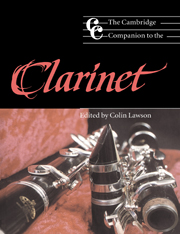Book contents
- Frontmatter
- 1 Single reeds before 1750
- 2 The development of the clarinet
- 3 The clarinet family
- 4 The development of the clarinet repertoire
- 5 Players and composers
- 6 The mechanics of playing the clarinet
- 7 Teaching the clarinet
- 8 Playing historical clarinets
- 9 The professional clarinettist
- 10 The contemporary clarinet
- 11 The clarinet in jazz
- 12 The clarinet on record
- Notes
- Appendices
- Select bibliography
- Index
9 - The professional clarinettist
Published online by Cambridge University Press: 28 September 2011
- Frontmatter
- 1 Single reeds before 1750
- 2 The development of the clarinet
- 3 The clarinet family
- 4 The development of the clarinet repertoire
- 5 Players and composers
- 6 The mechanics of playing the clarinet
- 7 Teaching the clarinet
- 8 Playing historical clarinets
- 9 The professional clarinettist
- 10 The contemporary clarinet
- 11 The clarinet in jazz
- 12 The clarinet on record
- Notes
- Appendices
- Select bibliography
- Index
Summary
Introduction
Whatever their preferred course at the outset, musicians these days are best equipped if they can apply themselves to several related trades. Playing a wind instrument can offer a most satisfying professional life combining orchestral work, solo playing, chamber music and teaching, but performers often end up diversifying in all sorts of directions. Examiners, lecturers, recording artists and producers, conductors, composers, businessmen, arrangers, authors, consultants, administrators in education or artistic managers – I can think of at least one clarinettist who has become each of these! Competition for rare orchestral vacancies is intense, whilst only one or two professional clarinettists in Britain can honestly say that they earn a living from playing solo and chamber music. There are, however, hundreds of players throughout the country who teach and many who play occasionally, if only in local amateur orchestras, bands or jazz groups. This has not always been the case. Between 1890 and 1900 the number of listed clarinettists in London increased tenfold, suggesting there was a time when the instrument was not as popular as it is today. Nowadays there is a flourishing market of freelance players supplying a large number of the capital's ad hoc orchestras and ensembles. Despite the risks of being a musician, it seems that playing the instrument for a living has never been so popular.
- Type
- Chapter
- Information
- The Cambridge Companion to the Clarinet , pp. 150 - 162Publisher: Cambridge University PressPrint publication year: 1995



